The Relevance of Surface Resistances on the Conductive Thermal Resistance of Lightweight Steel-Framed Walls: A Numerical Simulation Study
Abstract
1. Introduction
2. Materials and Methods
2.1. Walls Description and Material Characterization
2.2. Adopted Methodology
3. Numerical Simulations
3.1. Evaluated FEM Computational Tools
3.2. Domain Discretization and Boundary Conditions
- First stage
- Second stage
3.3. Model Accuracy Verifications and Validation
4. Results and Discussion
4.1. Partition LSF Walls
4.2. Facade LSF Walls
4.3. Homogeneous Layered Walls
4.4. Results Overview
5. Conclusions
- The accuracy of all evaluated computational tools was very high and similar;
- The value is nearly uniform for walls with homogeneous layers, as expected;
- The variation of the values depends on the level of inhomogeneity in the LSF wall layers;
- For the assessed values, the conductive thermal resistances increased up to 8.1%, i.e., +0.123 m2·K/W, for the partition cold frame LSF wall;
- However, the variation in values was almost negligible (only up to +0.2%) for the facade hybrid LSF wall with a continuous thermal insulation layer (50 mm thick);
- When removing the steel frames, the values of this simplified facade wall do not change, regardless of the values;
- However, when compared to the original LSF facade wall, the conductive thermal resistance values increased significantly (+34%);
- Numerical modelling and laboratory measurements are complementary methods, and the combination of them boosts the accuracy and the practical relevance of thermal performance analyses.
Author Contributions
Funding
Institutional Review Board Statement
Informed Consent Statement
Data Availability Statement
Conflicts of Interest
References
- European Parliament Directive 2002/91/EC of the European Parliament and of the Council of 16 December 2002 on the Energy performance of Buildings. Off. J. Eur. Commun. 2002, L1/65–L1/71.
- European Parliament. Energy Performance of Buildings (Recast), European Parliament Legislative Resolution of 12 March 2024 on the Proposal for a Directive of the European Parliament and of the Council on the Energy Performance of Buildings (Recast), COM(2021)0802–C9-0469/2021–2021/0426(COD); European Parliament: Strasbourg, France, 2024.
- Wang, H.; Zhai, Z. (John) Advances in Building Simulation and Computational Techniques: A Review between 1987 and 2014. Energy Build. 2016, 128, 319–335. [Google Scholar] [CrossRef]
- Vera-Piazzini, O.; Scarpa, M. Building Energy Model Calibration: A Review of the State of the Art in Approaches, Methods, and Tools. J. Build. Eng. 2024, 86, 108287. [Google Scholar] [CrossRef]
- Crawley, D.B.; Hand, J.W.; Kummert, M.; Griffith, B.T. Contrasting the Capabilities of Building Energy Performance Simulation Programs. Build. Environ. 2008, 43, 661–673. [Google Scholar] [CrossRef]
- Kim, S.-H.; Kim, J.-H.; Jeong, H.-G.; Song, K.-D. Reliability Field Test of the Air–Surface Temperature Ratio Method for In Situ Measurement of U-Values. Energies 2018, 11, 803. [Google Scholar] [CrossRef]
- ISO 9869-1; Thermal Insulation—Building Elements—In-Situ Measurement of Thermal Resistance and Thermal Transmittance. Part 1: Heat Flow Meter Method. ISO: Geneva, Switzerland, 2014.
- Evangelisti, L.; Guattari, C.; Asdrubali, F. Comparison between Heat-Flow Meter and Air-Surface Temperature Ratio Techniques for Assembled Panels Thermal Characterization. Energy Build. 2019, 203, 109441. [Google Scholar] [CrossRef]
- ISO 6946; Building Components and Building Elements—Thermal Resistance and Thermal Transmittance—Calculation Methods. ISO: Geneva, Switzerland, 2017.
- De Rubeis, T.; Evangelisti, L.; Guattari, C.; De Berardinis, P.; Asdrubali, F.; Ambrosini, D. On the Influence of Environmental Boundary Conditions on Surface Thermal Resistance of Walls: Experimental Evaluation through a Guarded Hot Box. Case Stud. Therm. Eng. 2022, 34, 101915. [Google Scholar] [CrossRef]
- Arregi, B.; Garay-Martinez, R.; Astudillo, J.; García, M.; Ramos, J.C. Experimental and Numerical Thermal Performance Assessment of a Multi-Layer Building Envelope Component Made of Biocomposite Materials. Energy Build. 2020, 214, 109846. [Google Scholar] [CrossRef]
- Moga, L.; Moga, I. Thermal Bridges at Wood Frame Construction. J. Appl. Eng. Sci. 2015, 5, 65–71. [Google Scholar] [CrossRef][Green Version]
- Murtinho, V.; Ferreira, H.; Antonio, C.; Simoes da Silva, L.; Gervasio, H.; Santos, P. Architectural Concept for Multi-Storey Apartment Building with Light Steel Framing. Steel Constr. 2010, 3, 163–168. [Google Scholar] [CrossRef]
- Santos, P.; Mateus, D.; Simoes Da Silva, L.; Rebelo, C.; Gervasio, H.; Correia, A.; Ferreira, H.; Santiago, A.; Murtinho, V.; Rigueiro, C. Affordable Houses (Part II): Functional, Structural and Technological Performance. In Proceedings of the Structures and Architecture—Proceedings of the 1st International Conference on Structures and Architecture, ICSA 2010, Guimaraes, Portugal, 21–23 July 2010. [Google Scholar]
- Soares, N.; Santos, P.; Gervásio, H.; Costa, J.J.; Simões da Silva, L. Energy Efficiency and Thermal Performance of Lightweight Steel-Framed (LSF) Construction: A Review. Renew. Sustain. Energy Rev. 2017, 78, 194–209. [Google Scholar] [CrossRef]
- de Angelis, E.; Serra, E. Light Steel-Frame Walls: Thermal Insulation Performances and Thermal Bridges. Energy Procedia 2014, 45, 362–371. [Google Scholar] [CrossRef]
- Santos, P.; da Silva, L.S.; Ungureanu, V. Energy Efficiency of Light-Weight Steel-Framed Buildings, 1st ed.; Technical Committee 14—Sustainability & Eco-Efficiency of Steel Construction; European Convention for Constructional Steelwork (ECCS): Mem Martins, Portugal, 2012; ISBN 978-92-9147-105-8. [Google Scholar]
- Santos, P.; Lemes, G.; Mateus, D. Analytical Methods to Estimate the Thermal Transmittance of LSF Walls: Calculation Procedures Review and Accuracy Comparison. Energies 2020, 13, 840. [Google Scholar] [CrossRef]
- Santos, C.; Matias, L. ITE50—Coeficientes de Transmissão Térmica de Elementos Da Envolvente Dos Edifícios; LNEC—Laboratório Nacional de Engenharia Civil: Lisboa, Portugal, 2006. (In Portuguese) [Google Scholar]
- Santos, P.; Mateus, D. Experimental Assessment of Thermal Break Strips Performance in Load-Bearing and Non-Load-Bearing LSF Walls. J. Build. Eng. 2020, 32, 101693. [Google Scholar] [CrossRef]
- Santos, P.; Lopes, P.; Abrantes, D. Thermal Performance of Lightweight Steel Framed Facade Walls Using Thermal Break Strips and ETICS: A Parametric Study. Energies 2023, 16, 1699. [Google Scholar] [CrossRef]
- Santos, P.; Poologanathan, K. The Importance of Stud Flanges Size and Shape on the Thermal Performance of Lightweight Steel Framed Walls. Sustainability 2021, 13, 3970. [Google Scholar] [CrossRef]
- Roque, E.; Santos, P. The Effectiveness of Thermal Insulation in Lightweight Steel-Framed Walls with Respect to Its Position. Buildings 2017, 7, 13. [Google Scholar] [CrossRef]
- Gyptec Ibérica Technical Sheet: Standard Gypsum Plasterboard. Available online: https://gyptec.eu/en/ (accessed on 10 February 2022).
- Kronospan Technical Sheet: Kronobuild Materials. Available online: https://de.kronospan-express.com/public/files/downloads/kronobuild/kronobuild-en.pdf (accessed on 10 February 2022).
- Volcalis Technical Sheet: Alpha Mineral Wool. Available online: https://volcalis.pt/ (accessed on 10 February 2022).
- LNEC Documento de Homologação: Tincoterm EPS—Sistema Compósito de Isolamento Térmico Pelo Exterior. Available online: http://www.lnec.pt/fotos/editor2/tincoterm-eps-sistema-co-1.pdf (accessed on 10 February 2022). (In Portuguese).
- WEBERTHERM UNO Technical Sheet: Weber Saint-Gobain ETICS Finish Mortar. Available online: https://construir.saint-gobain.pt/ (accessed on 10 February 2022). (In Portuguese).
- THERM Software Version: 7.8.57.0. Available online: https://windows.lbl.gov/therm-software-downloads (accessed on 14 February 2023).
- FLIXO Software Trial Version: 8.2.1178.1. Available online: https://www.flixo.com (accessed on 25 March 2024).
- Moga, I.; Moga, L. Model. Simul. Two-Dimensional Heat Transf. Build, PSIPLAN Software Version 2024. 2024.
- ANSYS Workbench: Steady-State Thermal Software Version: Student 2022 R1. Available online: https://www.ansys.com/academic/students/ansys-student (accessed on 10 February 2022).
- ISO 10211; Thermal Bridges in Building Construction—Heat Flows and Surface Temperatures—Detailed Calculations. International Organization for Standardization: Geneva, Switzerland, 2017.
- Santos, P.; Lopes, P.; Abrantes, D. Thermal Performance of Load-Bearing, Lightweight, Steel-Framed Partition Walls Using Thermal Break Strips: A Parametric Study. Energies 2022, 15, 9271. [Google Scholar] [CrossRef]
- Santos, P.; Mateus, D.; Ferrandez, D.; Verdu, A. Numerical Simulation and Experimental Validation of Thermal Break Strips’ Improvement in Facade LSF Walls. Energies 2022, 15, 8169. [Google Scholar] [CrossRef]
- Santos, P.; Ribeiro, T. Thermal Performance Improvement of Double-Pane Lightweight Steel Framed Walls Using Thermal Break Strips and Reflective Foils. Energies 2021, 14, 6927. [Google Scholar] [CrossRef]
- Santos, P.; Ribeiro, T. Thermal Performance of Double-Pane Lightweight Steel Framed Walls with and without a Reflective Foil. Buildings 2021, 11, 301. [Google Scholar] [CrossRef]
- Santos, P.; Gonçalves, M.; Martins, C.; Soares, N.; Costa, J.J. Thermal Transmittance of Lightweight Steel Framed Walls: Experimental Versus Numerical and Analytical Approaches. J. Build. Eng. 2019, 25, 100776. [Google Scholar] [CrossRef]
- Santos, P.; Martins, C.; Simoes da Silva, L.; Bragança, L. Thermal Performance of Lightweight Steel Framed Wall: The Importance of Flanking Thermal Losses. J. Build. Phys. 2014, 38, 81–98. [Google Scholar] [CrossRef]
- Santos, P.; Lemes, G.; Mateus, D. Mateus Thermal Transmittance of Internal Partition and External Facade LSF Walls: A Parametric Study. Energies 2019, 12, 2671. [Google Scholar] [CrossRef]
- Martins, C.; Santos, P.; Simoes da Silva, L. Lightweight Steel-Framed Thermal Bridges Mitigation Strategies: A Parametric Study. J. Build. Phys. 2016, 39, 342–372. [Google Scholar] [CrossRef]
- Santos, P.; Martins, C.; Júlio, E. Enhancement of the Thermal Performance of Perforated Clay Brick Walls through the Addition of Industrial Nano-Crystalline Aluminium Sludge. Constr. Build. Mater. 2015, 101, 227–238. [Google Scholar] [CrossRef]
- Moga, L.; Petran, I.; Santos, P.; Ungureanu, V. Thermo-Energy Performance of Lightweight Steel Framed Constructions: A Case Study. Buildings 2022, 12, 321. [Google Scholar] [CrossRef]
- Moga, L.; Moga, I. Specific Thermal Bridges at Load Bearing Masonry Buildings; UTPRESS: Cluj-Napoca, Romania, 2013. [Google Scholar]
- Moga, L.; Moga, I. Specific Thermal Bridges for Terrace Roofs, Attic Floors, Floors over the Basement and Slabs on the Ground at Load Bearing Masonry Buildings; UTPRESS: Cluj-Napoca, Romania, 2017. [Google Scholar]
- Marincu, C.; Dan, D.; Moga, L. Investigating the Influence of Building Shape and Insulation Thickness on Energy Efficiency of Buildings. Energy Sustain. Dev. 2024, 79, 101384. [Google Scholar] [CrossRef]
- Moga, L.; Moga, I. Numerical Modelling of Point Thermal Bridge’s Impact on the Thermal Performance of Facade Systems. IOP Conf. Ser. Mater. Sci. Eng. 2021, 1141, 012018. [Google Scholar] [CrossRef]
- Moga, L.; Moga, I. Evaluation of Thermal Bridges Using Online Simulation Software. E3S Web Conf. 2020, 172, 08010. [Google Scholar] [CrossRef]
- Moga, L.; Moga, I. Considerations on the Thermal Modelling of Insulated Metal Panel Systems. In Proceedings of the Healthy, Intelligent and Resilient Buildings and Urban Environments; International Association of Building Physics (IABP): Syracuse, New York, NY, USA, 23–26 September 2018; pp. 1235–1240. [Google Scholar]
- Rasooli, A.; Itard, L. In-Situ Characterization of Walls’ Thermal Resistance: An Extension to the ISO 9869 Standard Method. Energy Build. 2018, 179, 374–383. [Google Scholar] [CrossRef]
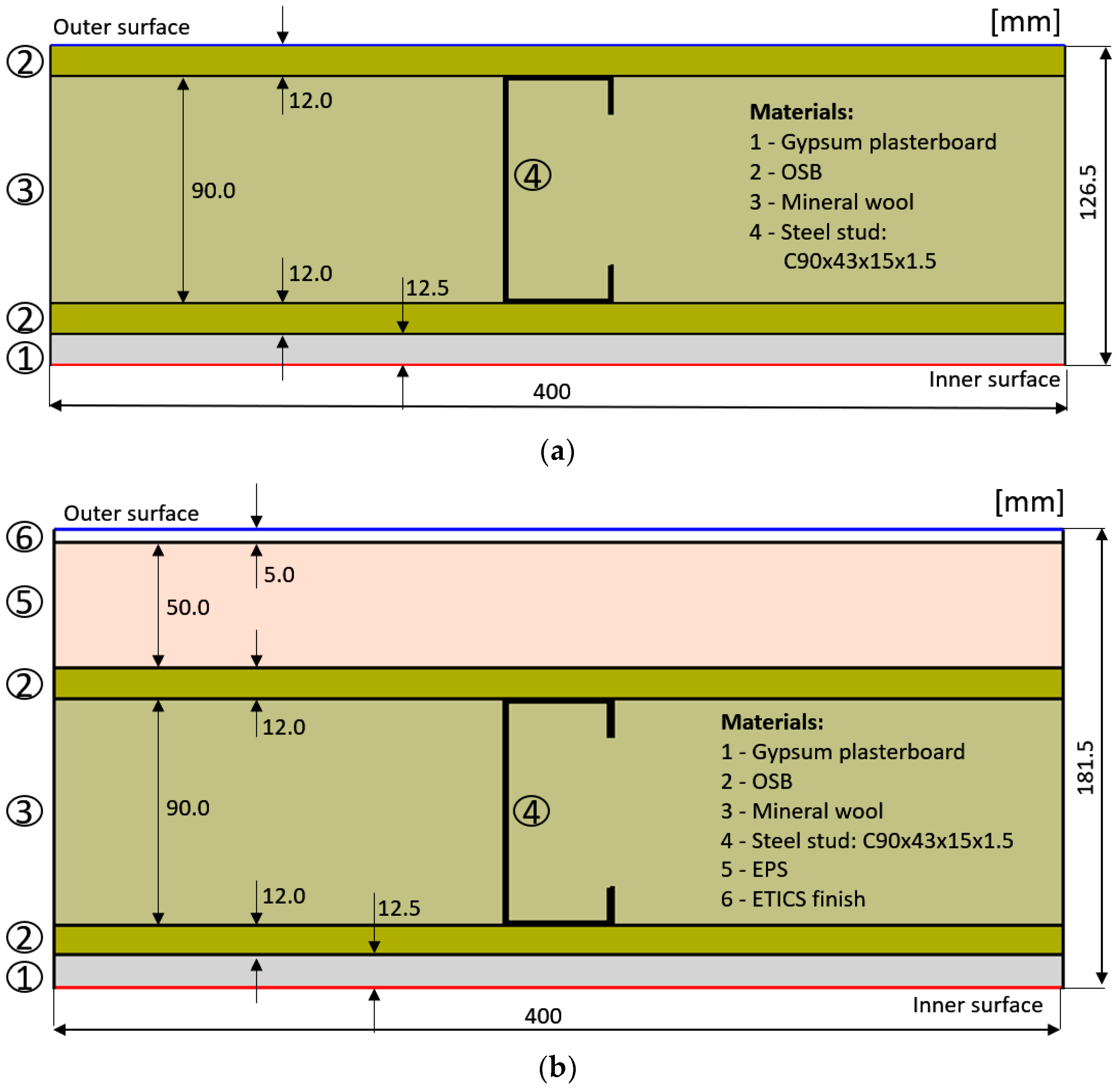
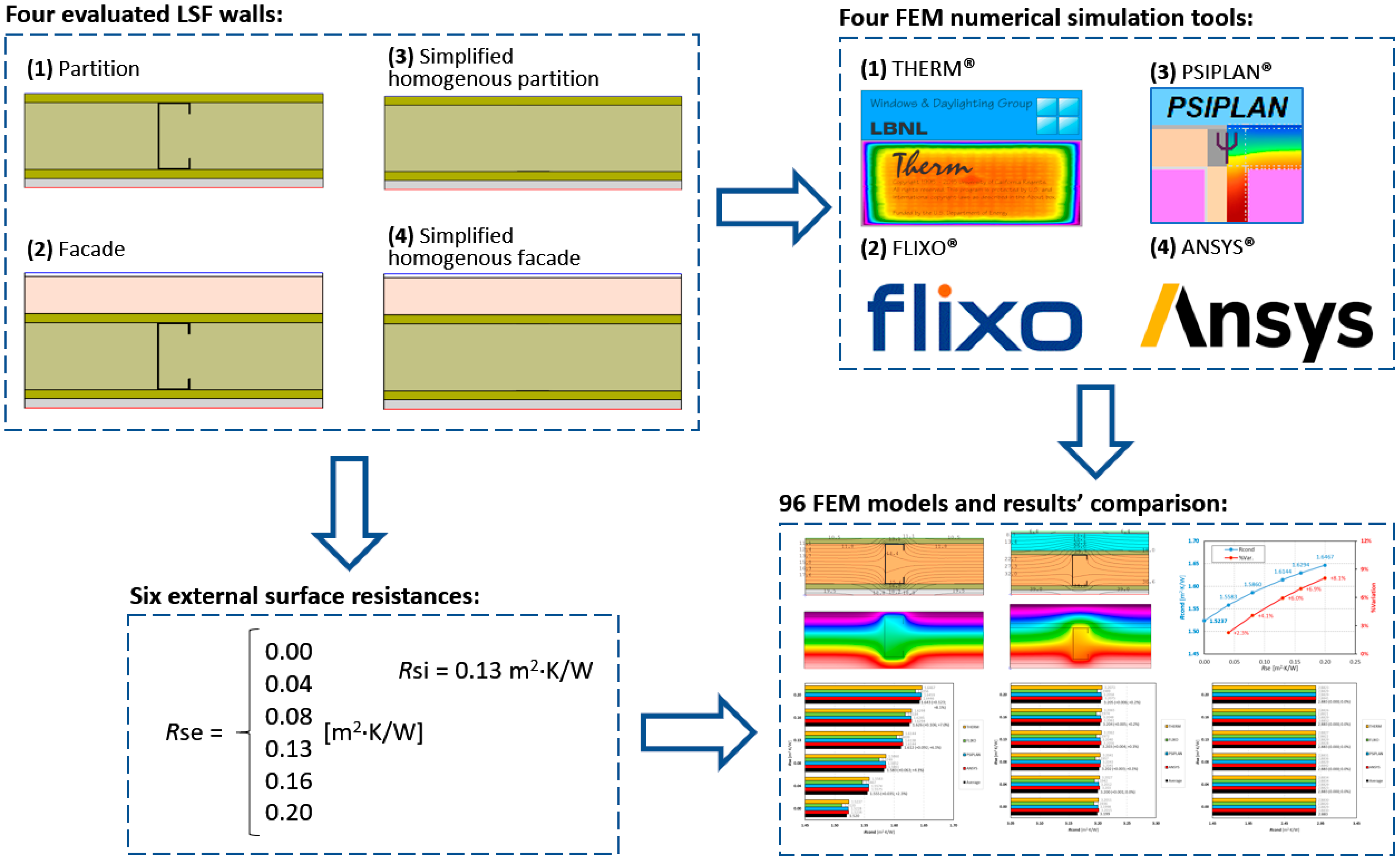

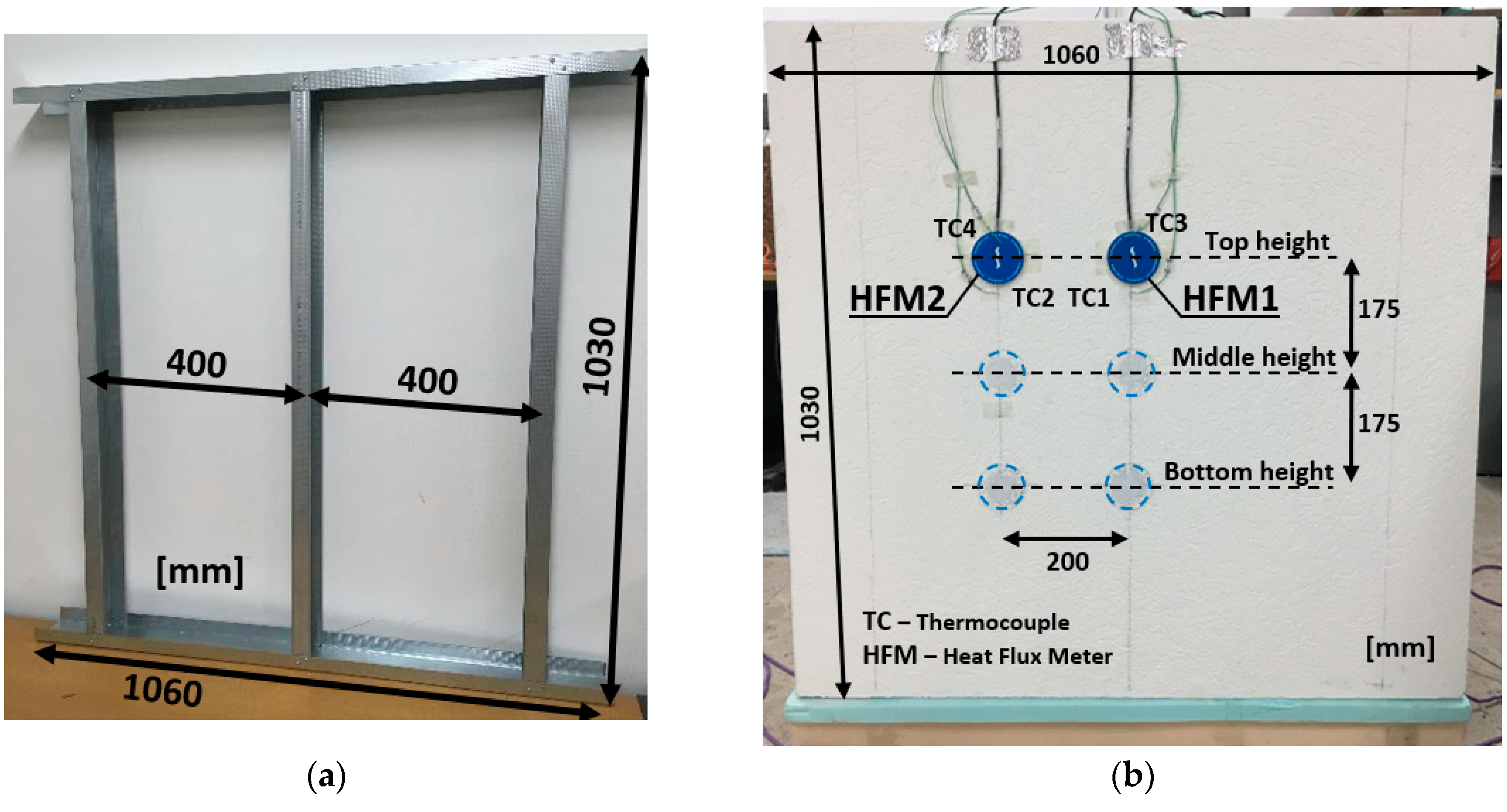

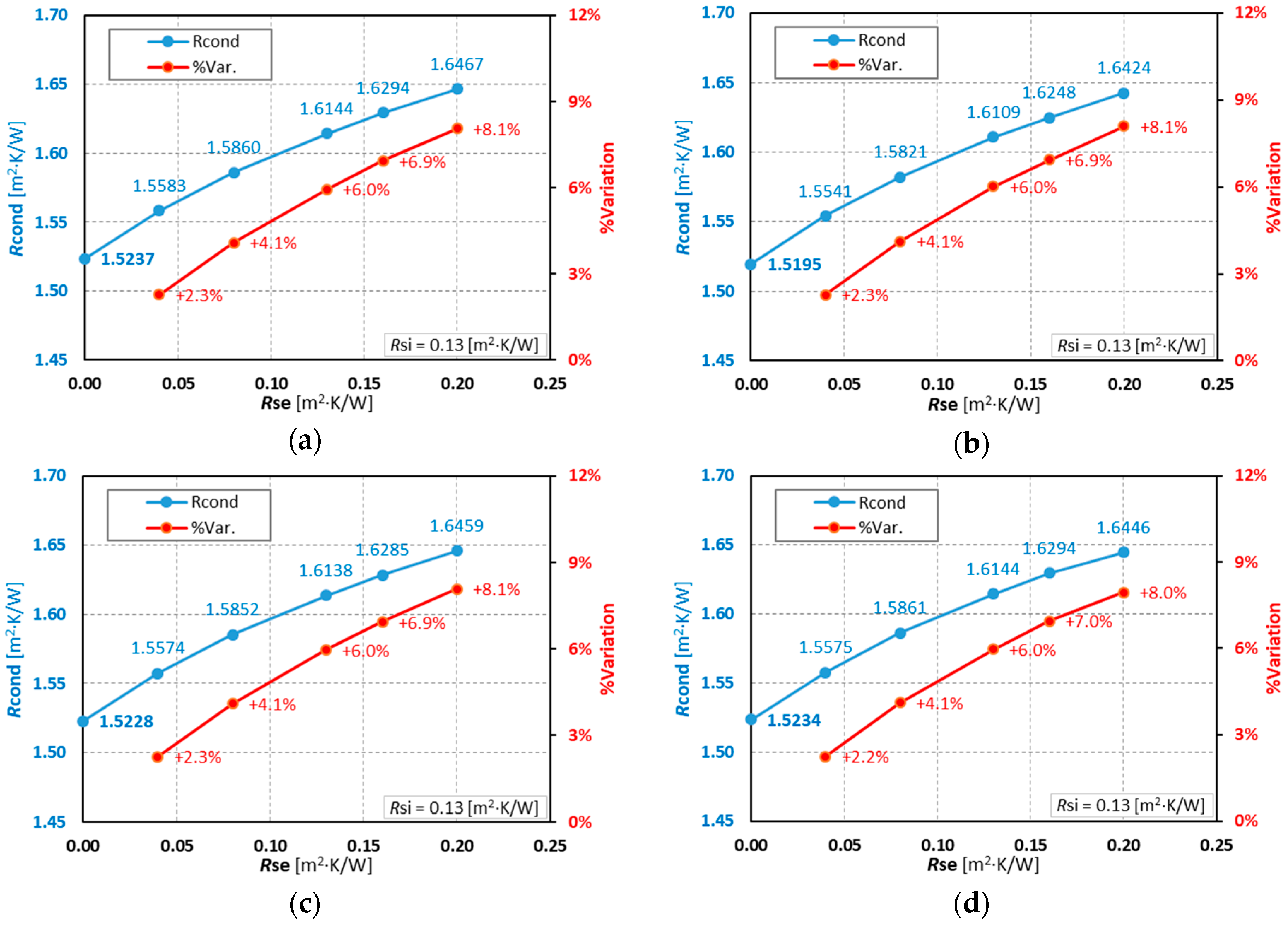
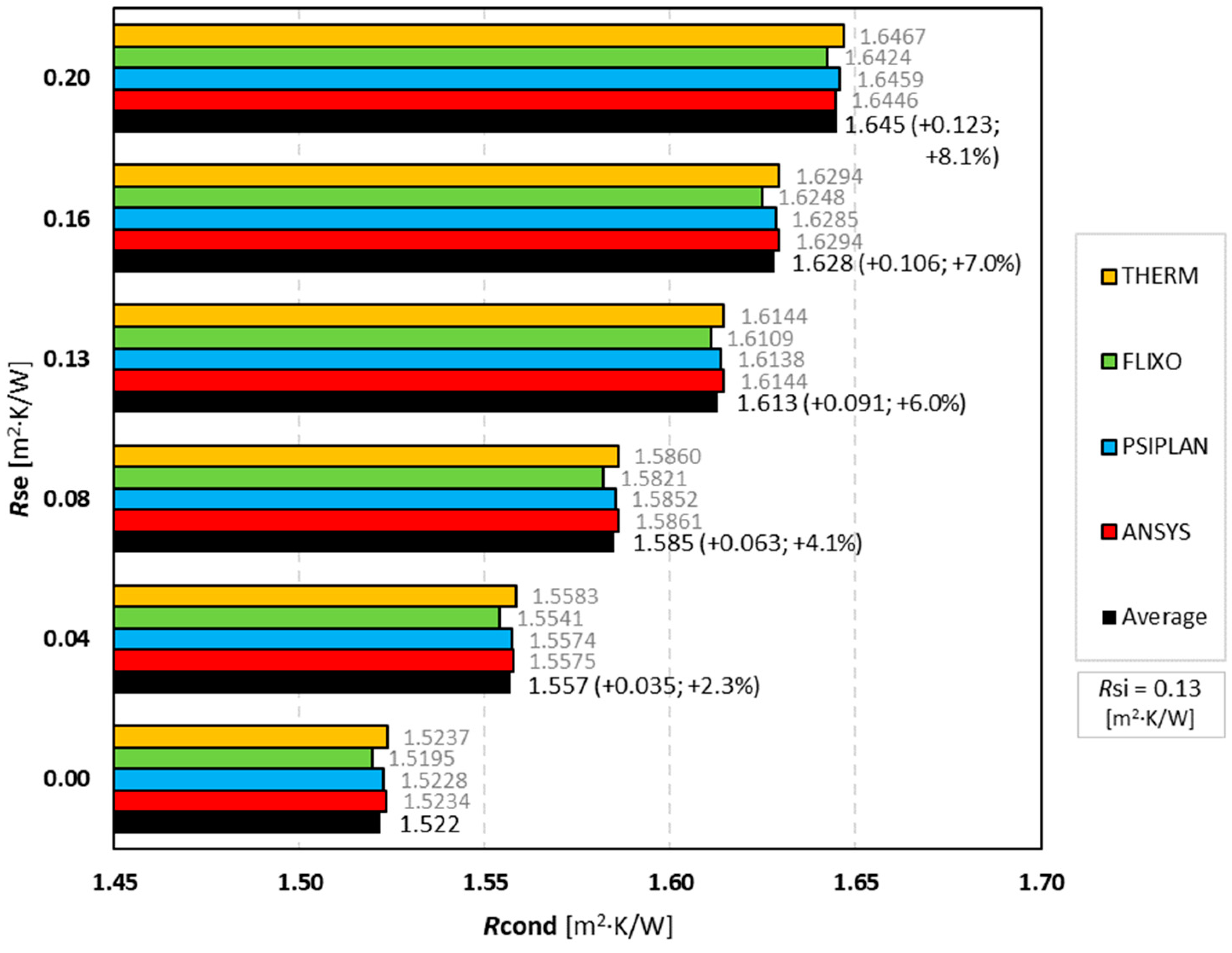
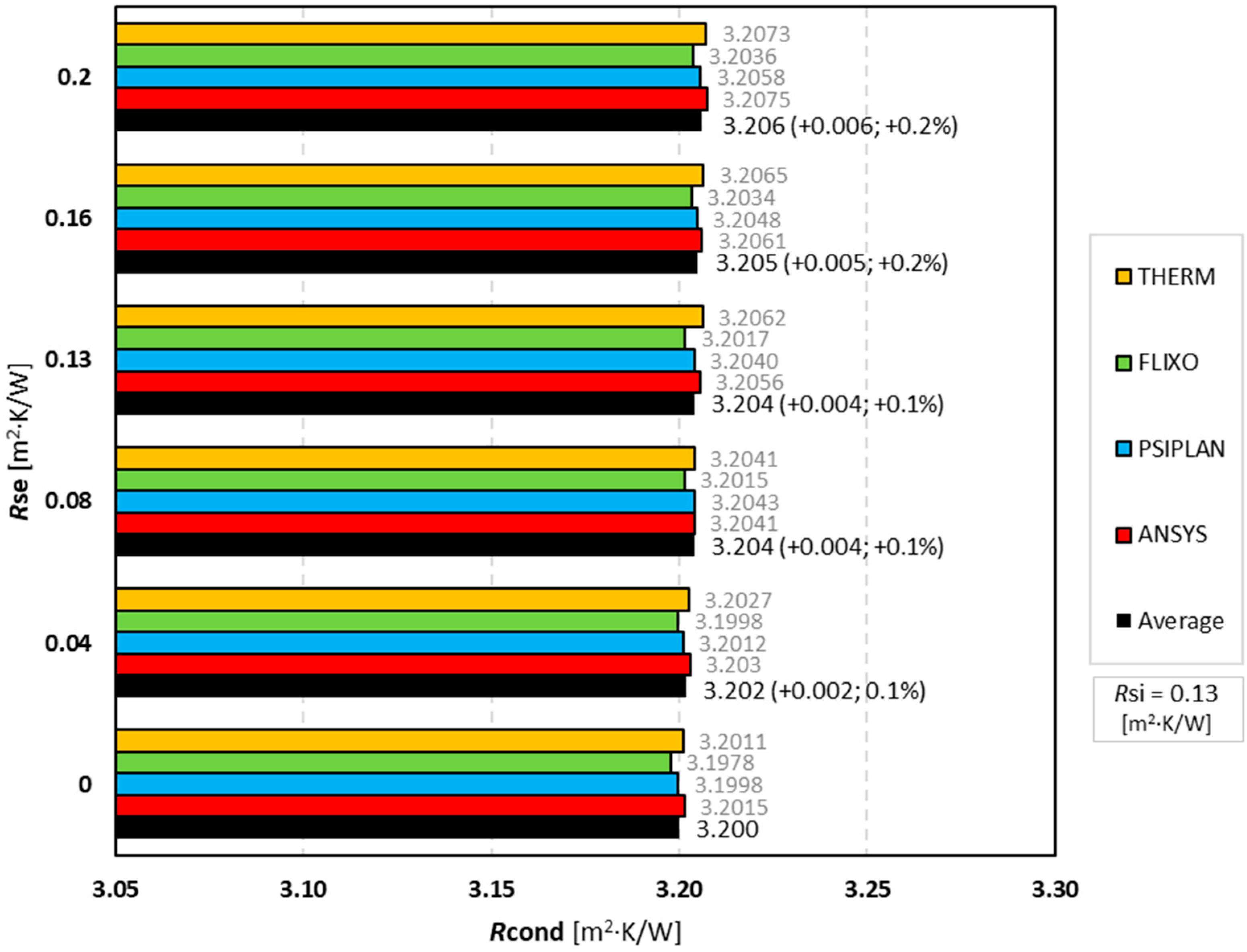
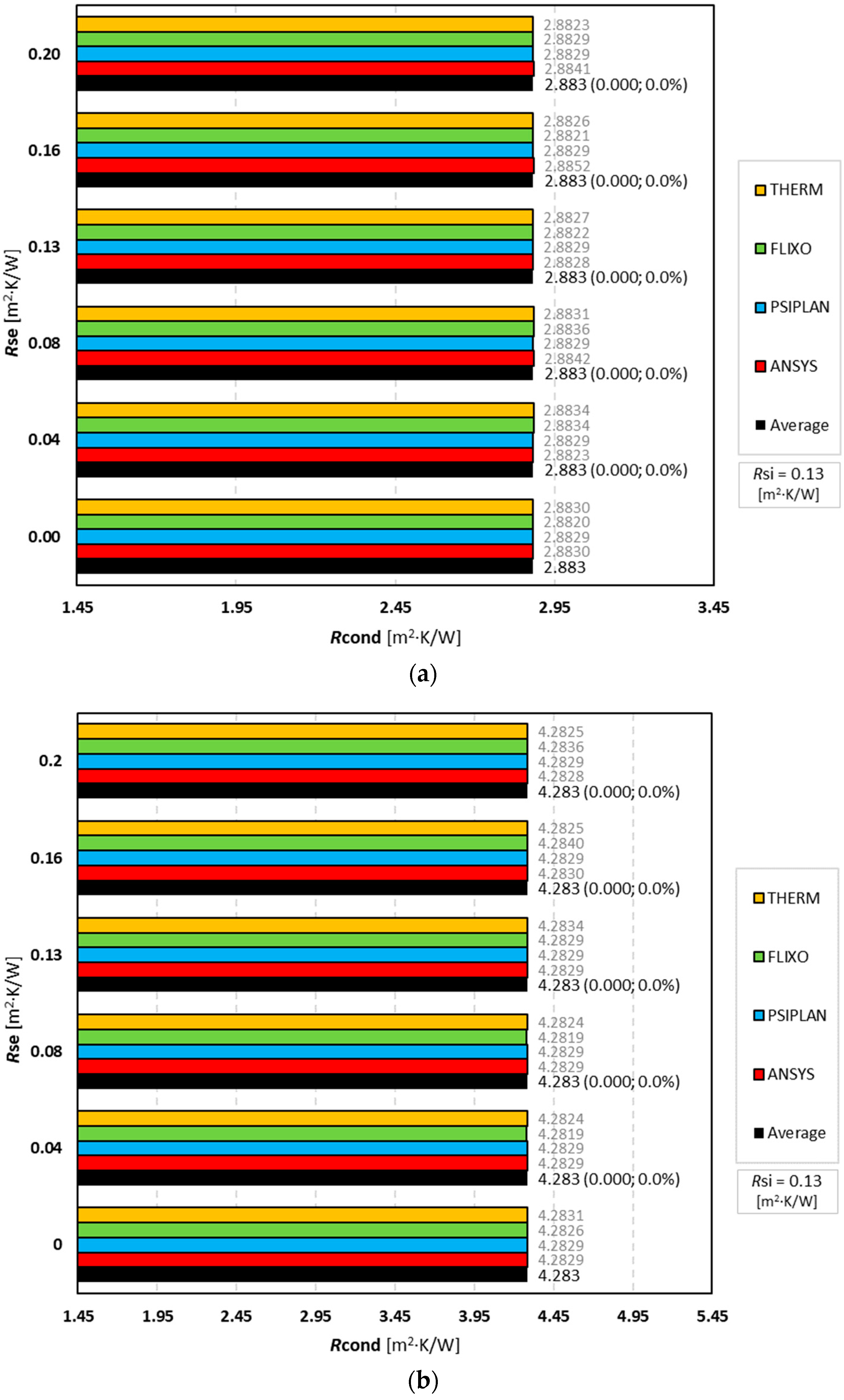

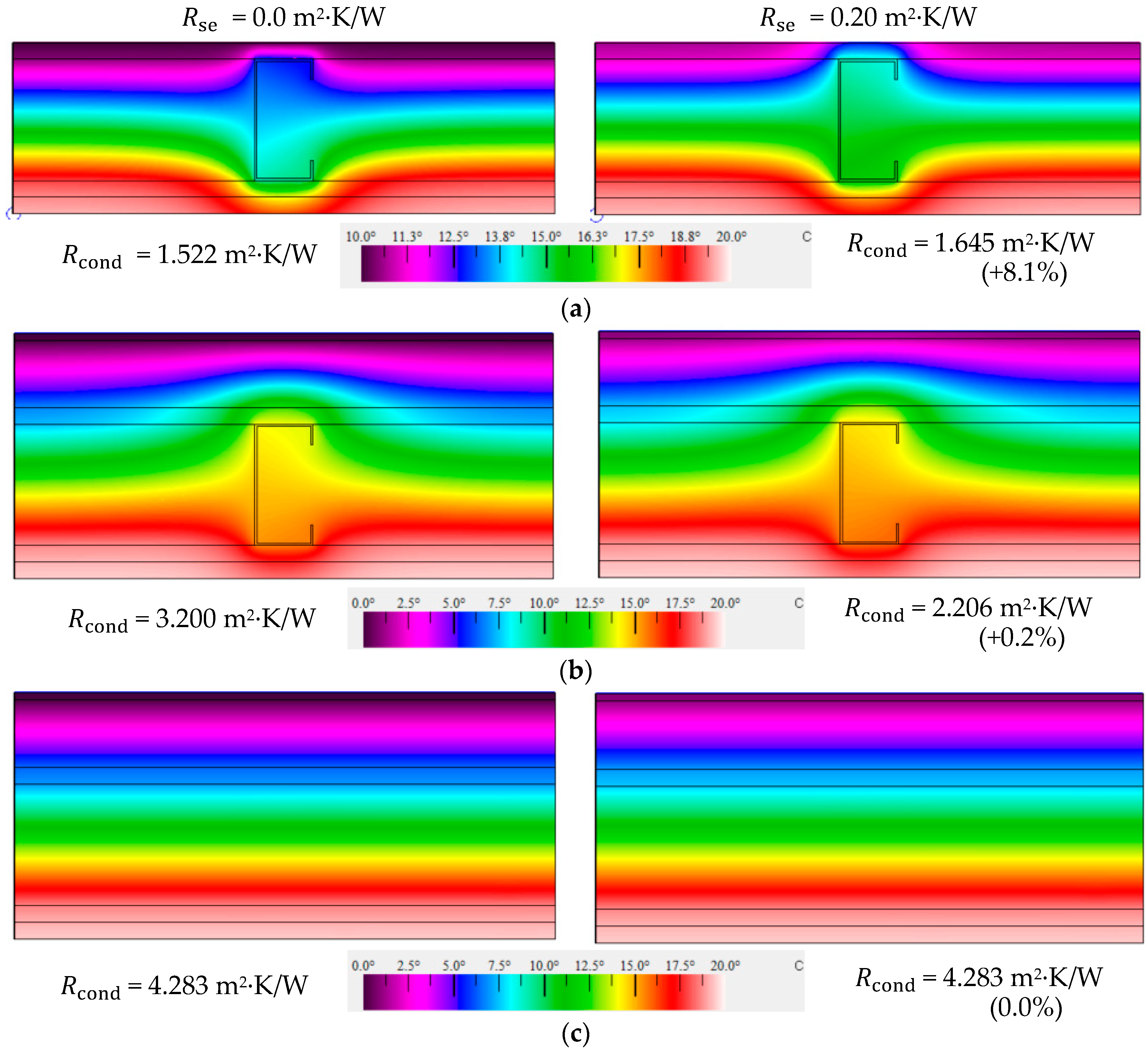
| Material | (mm) | (W/(m·K)) | Ref. |
|---|---|---|---|
| Gypsum Plaster Board (GPB) | 12.5 | 0.175 | [24] |
| Oriented Strand Board (OSB) | 12.0 | 0.100 | [25] |
| Mineral Wool (MW) | 90.0 | 0.035 | [26] |
| Steel Studs (C90 × 43 × 15 × 1.5) | 90.0 | 50.000 | [19] |
| ETICS 2 Insulation (EPS 1) | 50.0 | 0.036 | [27] |
| ETICS 2 Finish | 5.0 | 0.450 | [28] |
| (m2·K/W) | 0.13 | |||||
| (m2·K/W) | 0.00 | 0.04 | 0.08 | 0.13 | 0.16 | 0.20 |
| N. of nodes | 234 | 500 | 910 | 1739 | 3795 | 7546 | 19,468 |
| Step size (mm) | 16.0 | 8.0 | 4.0 | 2.0 | 1.0 | 0.5 | 0.2 |
| (W/model length) | 2.436365 | 2.373234 | 2.346557 | 2.331952 | 2.322983 | 2.318495 | 2.315669 |
| Differences | --- | −2.7% | −1.1% | −0.6% | −0.4% | −0.2% | −0.1% |
| (m2·K/W) | 1.471790 | 1.515464 | 1.534625 | 1.545301 | 1.551924 | 1.555257 | 1.557363 |
| -value (m2·K/W) | 1.641790 | 1.685464 | 1.704625 | 1.715301 | 1.721924 | 1.725257 | 1.727363 |
| Iterations | 1st | 2nd | 3rd | 4th | 5th | 6th | 7th |
|---|---|---|---|---|---|---|---|
| (W/model length) | 2.359532 | 2.322598 | 2.318905 | 2.318536 | 2.318499 | 2.318495 | 2.318495 |
| (W/model length) | 2.259720 | 2.312617 | 2.317907 | 2.318436 | 2.318489 | 2.318494 | 2.318495 |
| Precision | 0.043215 | 0.004307 | 0.000431 | 0.000043 | 0.000004 | 0.000000 | 0.000000 |
| (m2·K/W) | 1.526944 | 1.552381 | 1.554969 | 1.555228 | 1.555254 | 1.555257 | 1.555257 |
| -value (m2·K/W) | 1.695252 | 1.722209 | 1.724952 | 1.725227 | 1.725254 | 1.725257 | 1.725257 |
| Approach | Tool | -Value (W/(m2·K)) | |
|---|---|---|---|
| Partition | Facade | ||
| Analytical | ISO 6946 | 0.3182 | 0.2246 |
| Numerical | THERM | 0.3182 | 0.2246 |
| FLIXO | 0.3182 | 0.2246 | |
| PSIPLAN | 0.3182 | 0.2246 | |
| ANSYS | 0.3182 | 0.2246 | |
| Test N. | Sensors Location | (m2·K/W) | |
|---|---|---|---|
| Partition | Facade | ||
| 1 | Top | 1.607 | 3.247 |
| 2 | Middle | 1.576 | 3.121 |
| 3 | Bottom | 1.491 | 3.232 |
| Measurement Average | 1.558 | 3.200 | |
| Computed in THERM | 1.594 | 3.200 | |
| Percentage Deviation | +2.3% | 0.0% | |
| Computed in FLIXO | 1.590 | 3.196 | |
| Percentage Deviation | +2.1% | −0.1% | |
| Computed in PSIPLAN | 1.591 | 3.198 | |
| Percentage Deviation | +2.1% | −0.1% | |
| Computed in ANSYS | 1.586 | 3.206 | |
| Percentage Deviation | +1.8% | +0.2% | |
Disclaimer/Publisher’s Note: The statements, opinions and data contained in all publications are solely those of the individual author(s) and contributor(s) and not of MDPI and/or the editor(s). MDPI and/or the editor(s) disclaim responsibility for any injury to people or property resulting from any ideas, methods, instructions or products referred to in the content. |
© 2024 by the authors. Licensee MDPI, Basel, Switzerland. This article is an open access article distributed under the terms and conditions of the Creative Commons Attribution (CC BY) license (https://creativecommons.org/licenses/by/4.0/).
Share and Cite
Santos, P.; Abrantes, D.; Lopes, P.; Moga, L. The Relevance of Surface Resistances on the Conductive Thermal Resistance of Lightweight Steel-Framed Walls: A Numerical Simulation Study. Appl. Sci. 2024, 14, 3748. https://doi.org/10.3390/app14093748
Santos P, Abrantes D, Lopes P, Moga L. The Relevance of Surface Resistances on the Conductive Thermal Resistance of Lightweight Steel-Framed Walls: A Numerical Simulation Study. Applied Sciences. 2024; 14(9):3748. https://doi.org/10.3390/app14093748
Chicago/Turabian StyleSantos, Paulo, David Abrantes, Paulo Lopes, and Ligia Moga. 2024. "The Relevance of Surface Resistances on the Conductive Thermal Resistance of Lightweight Steel-Framed Walls: A Numerical Simulation Study" Applied Sciences 14, no. 9: 3748. https://doi.org/10.3390/app14093748
APA StyleSantos, P., Abrantes, D., Lopes, P., & Moga, L. (2024). The Relevance of Surface Resistances on the Conductive Thermal Resistance of Lightweight Steel-Framed Walls: A Numerical Simulation Study. Applied Sciences, 14(9), 3748. https://doi.org/10.3390/app14093748









